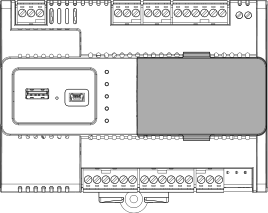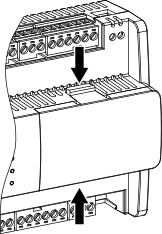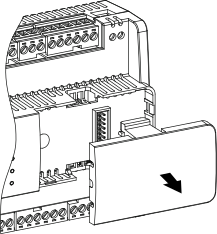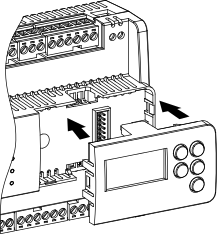Log on to rate and give feedback
1
2
3
4
5
Log on to rate
0

Explicación de procesos
Productos
IP-IO , MP-C
Funcionalidades:
Hardware
Versión del producto:
2023, 2024
20/06/2023
Installing MP-C Display
You install an MP-C Display module on the MP-C or IP-IO module to enable manual override control of the analog and digital outputs. The MP-C Display module cannot be removed.
Aviso
MP-C controller models with “-M” in the product name do not support the override display unit (MP-C Display).
To install MP-C Display
Disconnect power to the MP-C or IP-IO module.
Locate the blank face plate on the MP-C or IP-IO module.
action_zoom_plus_stroke 
Push and hold the two tabs on the blank face plate.
action_zoom_plus_stroke 
Remove the blank face plate by pulling it straight out.
action_zoom_plus_stroke 
Install the MP-C Display module in place of the blank face plate.
action_zoom_plus_stroke 
 MP-C Device Installation
MP-C Device Installation
 Installing MP-C on a DIN Rail
Installing MP-C on a DIN Rail
 Installing MP-C on a Flat Surface
Installing MP-C on a Flat Surface
 IP-IO Module Device Installation
IP-IO Module Device Installation
 Installing an IP-IO Module on a DIN Rail
Installing an IP-IO Module on a DIN Rail
 Installing an IP-IO Module on a Flat Surface
Installing an IP-IO Module on a Flat Surface










